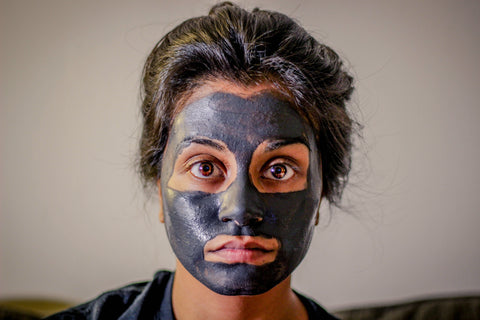DIY Clay Mask Recipes for Clear Skin


There are a huge variety of face masks on the market, with all sorts of exotic and unpronounceable ingredients. We believe that out of all of these, clay masks really rise above the rest. So, we've decided to share a couple DIY clay mask recipes that contain natural yet powerful ingredients to help you achieve a clear complexion. Here are 5 reasons why you should make clay masks an addition to your anti-aging skin care routine!
1. They work for ALL skin types!
Some of the ingredients will vary specific for dry, oily, sensitive or normal skin, but in general, clay masks work really well for a variety of skin types. They cause virtually no irritation or redness and can work wonders for acne. Not to mention boosting elasticity and promoting collagen production for a more youthful glow.
2. Gets rid of dirt and build-up!
Throughout the day, your skin accumulates dirt from the atmosphere and free radicals from a variety of environments we find ourselves in. Clay masks eliminate the dirt and penetrate beneath the skin’s surface to remove that build-up and the toxins that affect our skin’s health. Excess oil mixed with these toxins can lead to serious acne breakouts and using masks regularly will help to prevent them.
3. Clay masks absorb oil!
Oily skin is often associated with younger skin, but that’s not always the case. Oily skin can occur on anyone given a variety of factors like the products you use, environment, stress and genetics. But using clay masks will help to absorb excess oil while leaving the skin’s necessary oils intact to help hydrate and keep your skin from getting too dry.
4. They saturate the skin with nutrients!
After the oil that can lead to problem skin has been eliminated, the nutrients within clay masks can be absorbed into the skin and improve its appearance by making it brighter, clearer and smoother. Clay masks are loaded with minerals and nutrients that our skin needs to be healthy.
5. Clay masks remove dead skin cells!
If you’ve experienced the look of dead skin cells, than most likely your skin looked dull, flaky and irritated. Using clay masks regularly to help remove dead skin cells will leave your skin looking fresh, revitalized and you’ll be well on your way to a smoother complexion.
Using a clay mask regularly will do wonders for your skin. But depending on your skin type, use the mask 1 to 2 days a week as part of your normal daily skin regimen. This will be sufficient to helping you restore your skin’s health, revealing the complexion you’ve been looking for without over drying or irritating even the gentlest of skin.

Types of Clay
Since there are a variety of different options when it comes to clay masks, let’s break down the benefits of different types of clay and what type of skin they work best for to help you make the right choice when introducing a clay mask to your skin care routine.
Pink Clay
Also known as rose clay, this particular ingredient is great for normal to dry skin. It works to improve circulation throughout your face and remove dead skin cell build-up that causes skin to be dull and flaky.
White Clay
Sometimes referred to as kaolin clay, it’s best used for sensitive or slightly dry skin because of the natural properties that work to remove toxins without removing natural oils that protect the skin’s surface. It won’t dry out skin that may already be lacking hydration.
Yellow Clay
Yellow clay has a slightly more grainy texture that is also great for sensitive or dry skin. It’s able to gently exfoliate without irritating the skin and helps boost collagen production and circulation for a healthy, natural glow.
Green Clay
Also known as bentonite clay; Arguably the most commonly used skin care clay powder, it comes from volcanic ash and its anti-aging efforts to restore soft and supple skin by tissue regeneration and increasing blood flow bring life back into your skin and works best with all skin types, but especially for those with oily skin or larger pores because of the absorbent characteristics of ingredients like magnesium, calcium, potassium, silicon, iron and copper. It draws out impurities from the skin while toning and firming. It works to tighten pores and reveal a smoother, younger looking complexion. Read more about the benefits of bentonite here.
Blue Clay
The therapeutic properties of blue clay help to regenerate skin cells and tighten pores. It builds skin’s firmness and elasticity with consistent use. This type of clay is great for all skin types.
Shopping around for the right mask can be tricky with so many options. Consider this anti-aging and purifying clay mask by Geneva Naturals, perfect for all skin types and sulfate and paraben free. It’s made up of a mixture of bentonite and kaolin clays to detox your skin while bringing minerals and natural ingredients to nourish and hydrate. Your skin will feel smooth and more balanced by the use of antioxidants like cranberry and willow bark.
DIY Clay Masks for your Face
If you’re interested in trying to purchase the ingredients and make clay masks at home, we’ve compiled some mixtures for you to try. When using a DIY recipe that calls for clay, you can use any type of clay listed above based on your skin type or accessibility. All different types of clay can be purchased in small or large quantities. Consider some of these DIY recipes at home to try making a mud mask at home and enjoy the results of tighter, fresher, more youthful looking skin!

Detox Clay Mask
- 2 Tbsp. bentonite clay
- 2 tsp. organic turmeric
- 1-2 Tbsp. unrefined coconut oil
- 2-4 Tbsp. witch hazel
- Sealable jar
- Start with 2 Tbsp. bentonite clay in mixing bowl, add 2 tsp. turmeric. Next, add 2-4 Tbsp. of witch hazel to start, you may need to slowly add more if mixture becomes to thin, you want it fairly thick.
- Add 1-2 Tbsp. coconut oil and begin blending ingredients together using a plastic or wooden spoon (not a metal one). You may want to soften the coconut oil a little first for easier mixing.
- Once the consistency is right where you want it, scoop the mixture into the jar and seal it tightly. Contents can be stored in a cool, dark place for up to 30 days.
Apply the mask gently to your face avoiding the area around your eyes and mouth. (Try using the back of a spoon to apply because the turmeric can stain your hands and fingernails.) Allow mask to sit for 15-20 minutes and remove with a warm, wet wash cloth. *Do not use a white washcloth because it will stain. If your skin is left with a yellowish tint, use some witch hazel on a cotton ball around your face as if you would your regular toner. Be sure to follow with your favorite moisturizer.
Consider these alternatives:
- The witch hazel can also be replaced with apple cider vinegar or micellar water.
- Because the turmeric can stain, you could consider eliminating the ingredients all together if you have extremely fair skin or use a smaller amount to see your skin’s response to it the first time.
- Feel free to add any additional essential oils to the mask for extra hydration and aromatherapy.
Charcoal Clay Mask
- 3 Tbsp. bentonite clay
- 1 tsp. activated charcoal
- 3 Tbsp. witch hazel (also micellar water or apple cider vinegar would work)
- 20 drops tea tree oil
- 3 g. hyaluronic serum
- Silicone tube dispenser
- Mix together the bentonite clay and activated charcoal using a plastic or wooden spoon (do not use a metal one). Add in the witch hazel and tea tree oil to the clay mixture and stir until clay has absorbed the liquid.
- Mix them until well combined, then sore in silicone tube dispenser to prevent bacteria contamination.
- Contents can be stored in a cool, dark place for up to 30 days.
Apply the mask gently to your face; be sure to avoid the area around your eyes and mouth. Allow the mask to sit until completely dry, follow by rinsing the mask with warm water and gently pat to dry. Finish off the process by applying your favorite moisturizer.
Consider these alternatives:
- The witch hazel can also be replaced with apple cider vinegar or micellar water.
- You can replace the tea tree oil with an essential oil of your choice. Jojoba oil is a great alternative for sensitive skin, while lemon or orange are well suited for oily skin. If your skin is prone to breakouts, you may try lavender and for added hydration, try substituting with sandalwood or geranium. To add an anti-aging element, try rose or cypress.
- If you don’t have any hyaluronic serum, this ingredient can be eliminated or substituted for an additional Tbsp. of witch hazel.
For more varieties of clay masks with bentonite and charcoal, watch this video tutorial from ForeverRikk:
Deep Cleansing Clay Mask
- 1 tsp. bentonite clay
- 1 tsp. raw honey
- 1 tsp. water
- ½ tsp. powdered calendula (optional)
- 2 drops of lavender essential oil
- Mix the clay with calendula in a small bowl.
- Slowly add the honey to form a thick, paste like formula and add water. Mix in drops of essential oil well.
- This recipe makes 1 mask, but if you’re interested in storing the mask for future uses, simply increase in equal amounts and store in a small, glass jar or silicone tube dispenser for easy extraction.
- Ingredients can be stored at room temperature for up to 30 days.
Apply mixture to your face gently; avoid the area around your mouth and eyes. Leave the mask on for 10-15 minutes or until the mask is completely dry. Wash off using a dark colored wash cloth and warm water. Pat your face gently to dry and follow up with your favorite moisturizer.
Soothing Green Clay Mask
- 1 ½ tsp. green clay
- ½ tsp. white clay
- 1 ½ Tbsp. aloe vera gel
- 1 Tbsp. rose water
- 2 drops rose essential oil
- Mix green and white clay together in a small bowl. Add the aloe vera gel, rose water and oil.
- This recipe also makes just 1 mask, but if you’re interested in storing the mask for future uses, simply increase in equal amounts and store in a small, glass jar or silicone tube dispenser for easy extraction.
- Mask mixture should be stored in the refrigerator for up to 30 days in airtight container.
Apply the mask directly from the refrigerator to your face, but avoid the area around your eyes and mouth. Leave the mask on for 15-20 minutes. Wash off using warm water and pat your skin gently to dry. Follow with your favorite moisturizer.
Consider these alternatives:
- Rose water may be substituted with molecular water or witch hazel.
- You can replace the rose oil (effective for all skin types) with an essential oil of your choice. If you’re looking for an essential oil suited to your skin type, consider using cedar wood or geranium for skin that tends to be drier. To help calm the skin and prevent breakouts, use lavender or tea tree oil. And if oily skin is your concern, substitute rose oil for lemon or orange.
Simple Clay Mask
- ½ cup bentonite clay
- 1 cup water
- 1 tsp. honey
- 5 drops favorite essential oil
- Mix the water into the clay to form a paste. Add the honey and more liquid if consistency is too dry.
- Drop in favorite essential oil and mix together in a small bowl.
- Scoop mask into airtight container for storage; can be stored up to 30 days at room temperature.
Apply the mask all over your face, avoiding the area around your eyes and mouth. Let the mask sit for 15-20 minutes before rinsing with warm water. Pat face to dry and follow with your favorite moisturizer.
Consider these alternatives:
- If your skin tends to be drier, use ½ cup water and ½ cup coconut or jojoba oil for added hydration.
- See the recipes above for best essential oils for your specific skin type.
Because clay masks have legitimate benefits for your skin, they’re a no brainer when it comes to getting new skin for the new year! Get the skin you’ve always wanted this year by adding a clay mask to your skin care regimen. Finding the right mask can do wonders, not to mention they’re a great way to unwind, relax at the end of a long day or busy weekend. So slather on that mask and Netflix a rerun of The Office. Win win!
Don't feel like going through the DIY process? Check out our purifying clay mask as well as other natural skin care products:
Also in Geneva Naturals

What Is A Retinoid Oil? Retinoid Oil Benefits, Uses, Effects & More

Yoga Poses for Better Breasts



